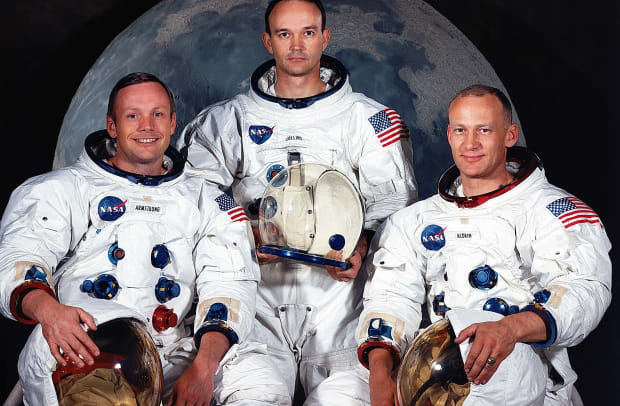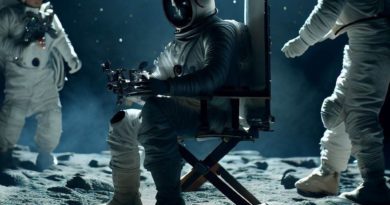8 Little-Known Facts About the Moon Landing
It was a feat for the ages. Just seven years before, a young president had challenged the nation to land a man on the moon—not because it was “easy,” as John F. Kennedy said in 1962, but because it was “hard.” By July 20, 1969, Neil Armstrong backed down a ladder and onto the moon’s surface.
Along the way to achieving JFK’s vision, there was plenty of hard work, drama and surprise. Here are some lesser-known moments throughout the epic U.S. effort to reach the moon.
Watch Moon Landing: The Lost Tapes on HISTORY Vault
1. Moon dirt smells.
A big question facing the NASA team planning the Apollo 11 moon landing was what would the moon’s surface be like—would the lander’s legs touch down on firm ground, or sink into something soft? The surface turned out to be solid, but the real surprise was that the moon had a smell.
Moon soil is extremely clingy and hard to brush off, so when Armstrong and Aldrin returned to the lunar module and repressurized it, lunar dirt that had clung to the men’s suits entered the cabin and began to emit an odor. The astronauts reported that it had a burned smell like wet fireplace ashes, or like the air after a fireworks show.
Scientists would never get the chance to investigate just what the crew was smelling. While moon soil and rock samples were sent to labs in sealed containers, once they were opened back on Earth, the smell was gone. Somehow, as Charles Fishman, author of One Giant Leap, says, “The smell of the moon remained on the moon.”
Watch video: Apollo 11: What the Moon Smells Like
2. JFK was more focused on beating the Soviets than in space.
In public, President John F. Kennedy had boldly pledged that the United States would “set sail on this new sea because there is new knowledge to be gained, and new rights to be won, and they must be won and used for the progress of all people.”
But secret tapes of Kennedy’s discussions would later reveal that in private, JFK was less interested in space exploration than in one-upping the Soviets.
In a 1962 meeting with advisors and NASA administrators, JFK confessed, “I’m not that interested in space.” But he was interested in winning the Cold War. Just months after JFK’s inauguration, the Soviet Union had sent the first man into space. Kennedy asked his vice president, Lyndon B. Johnson, how the U.S. could score a win against the Soviets.
One of the best ways to show U.S. dominance, Johnson reported back, was by sending a manned mission to the moon. Johnson, in fact, had long been a space advocate, saying in 1958, “Control of space is control of the world.”
Watch video: Apollo 11: JFK’s Secret Space Tapes
3. The Soviets covered up their efforts to get to the moon first.
It turns out that the United States wasn’t alone in wanting to demonstrate its dominance by landing humans on the moon. The Soviet Union was also gunning to accomplish the feat. But once U.S. astronauts got there first, the Soviets tried to keep their efforts on the down-low.
At first, “secrecy was necessary so that no one would overtake us,” wrote journalist Yaroslav Golovanov in the Soviet newspaper, Komsomolskaya Pravda. “But later, when they did overtake us, we had to maintain secrecy so that no one knew that we had been overtaken.”
READ MORE: The Soviet Response to the Moon Landing? Denial.
4. Astronauts trained for microgravity by walking “sideways.”
How do you prepare to send someone to a place no one has ever gone before? For NASA in the 1960s, the answer was to create simulations that mimicked aspects of what astronauts could expect to encounter.
Armstrong and Aldrin rehearsed collecting samples on fake, indoor moonscapes. Armstrong practiced taking off and landing in the Lunar Landing Training Vehicle in Houston. And, to simulate walking in the moon’s lower-gravity atmosphere, astronauts were suspended sideways by straps and then walked along a tilted wall.
NASA and the U.S. Geological Survey even blasted out craters at Cinder Lake, Arizona to create a landscape that matched part of the moon’s surface—because, after all, practice makes perfect.

A test subject being suited up for studies on the Reduced Gravity Walking Simulator at Langley Research Center, 1963.
NASA
SEE PHOTOS: How Astronauts Trained for the Apollo Moon Missions
Scroll to Continue
5. Civil Rights activists got a front-row seat to the Apollo 11 launch.
Not everyone was gung-ho about the U.S. effort to land people on the moon. A few days before the scheduled launch of Apollo 11, a group of activists, led by civil rights leader Ralph Abernathy, arrived outside the gates of the Kennedy Space Center. They brought with them two mules and a wooden wagon to illustrate the contrast between the gleaming white Saturn V rocket and families who couldn’t afford food or a decent place to live.
Amid the heady build-up to the launch, the NASA administrator, Thomas Paine, came out to talk to the protestors, face-to-face. After Paine and Abernathy talked for a while under lightly falling rain, Paine said he hoped Abernathy would “hitch his wagons to our rocket, using the space program as a spur to the nation to tackle problems boldly in other areas, and using NASA’s space successes as a yardstick by which progress in other areas should be measured.”
Paine then arranged to have members of the group attend the next day’s launch from a VIP viewing area. Abernathy prayed for the safety of the astronauts and said he was as proud as anyone at the accomplishment.
READ MORE: Why Civil Rights Leaders Protested the Moon Landing
6. Buzz Aldrin took holy communion on the moon.
When Apollo 11‘s Eagle lunar module landed on the moon on July 20, 1969, astronauts Neil Armstrong and Buzz Aldrin had to wait before venturing outside. Their mission ordered them to take a pause before the big event.
So Aldrin used some of the time doing something unexpected, something no man had ever attempted before. Alone and overwhelmed by anticipation, he took part in the first Christian sacrament ever performed on the moon—a rite of Christian communion.

The communion bag and chalice used by Buzz Aldrin during his lunar communion.
David Frohman, President of Peachstate Historical Consulting, Inc.
Read more: Buzz Aldrin Took Holy Communion on the Moon. NASA Kept it Quiet
7. Scientists were worried about space germs infecting Earth.
After risking their lives for the advancement of humanity, Armstrong, Aldrin and Collins had the dubious pleasure of being stuck in planetary protection quarantine on their return. Since humans had never been to the moon before, NASA scientists couldn’t be sure that some deadly space-borne plague hadn’t hitched a ride on the astronauts.
As soon as their re-entry capsule splashed down in the Pacific Ocean on July 24, the trio was transferred to a mobile quarantine facility inside which they were transported to NASA Lunar Receiving Laboratory at Johnson Space Center where they had access to a larger quarantine facility until their release on August 10, 1969.

President Richard Nixon speaking with Apollo 11 crew members Neil Armstrong, Michael Collins and Buzz Aldrin who were subjected to a period of quarantine upon their return to Earth.
MPI/Getty Images
READ MORE: 5 Terrifying Moments During the Apollo 11 Moon Landing Mission
8. President Nixon was anxious the mission could fail.
While President Kennedy had rallied the nation to land a man on the moon, he was assassinated before he could see the Apollo mission achieve his vision. That nerve-racking honor fell to President Richard Nixon, who had been elected in 1968.
Watching Neil Armstrong and Buzz Aldrin take their first steps on the moon, Nixon’s anxiety reached a peak. If anything went wrong, he would have to manage America’s outrage over billions of tax dollars culminating in the death of two astronauts.
His staff had prepared a statement to be read in the event the worst happened and organized a priest to commit their souls to the deep, much like a burial at sea.
Watching Apollo 11 live from the moon, the President could only hope he wouldn’t have to read it.
He didn’t. The men who had traveled more than 200,000 miles to the moon and then stepped foot on an alien world had survived. And the United States would go on to complete six crewed missions that landed a total of 12 astronauts on the moon from 1969 to 1972.
Listen: Nixon Calls Apollo 11 Astronauts
Read more: How JFK, LBJ and Nixon All Put Their Stamp on the Apollo 11 Moon Landing
Read more: How Many Times Has the U.S. Landed on the Moon?
Read more: Why the Air Force Almost Blasted the Moon with an H-Bomb
Read more: The Amazing Handmade Tech That Powered Apollo 11’s Moon Voyage




